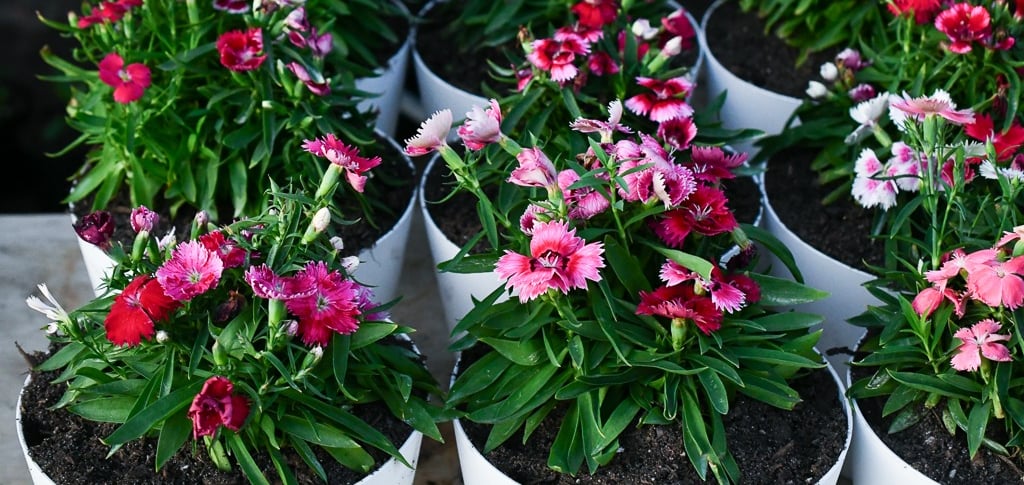Mitigating Outback Summer Heat Stress on Potted Plants


At Ironstone Garden Centre, we’ve been observing how extreme temperatures in the Central Western Queensland outback affect our plants—especially those still in pots, exposed to direct sunlight. With the average summer temperature often exceeding 36°C, we’ve taken steps to reduce heat stress in our nursery by introducing white self-watering pots for our smaller potted plants. These pots have been scientifically shown to mitigate overheating and improve plant survival during hot days.
Heat Impact: Black vs White Pots
To appreciate why white pots make such a difference, let's look at the heat absorption characteristics of different pot colours. Consider a typical 36°C day in the sun:
1. Incident Solar Radiation
A cylindrical pot with a total surface area of 0.1884 m², exposed to sunlight for 8 hours, receives solar radiation at 1000 W/m². We assume that only one-third of the pot is exposed to direct sunlight due to the natural obstructions around the nursery, so the surface area exposed is:
A = 1/3 * 0.1884 = 0.0628 m²
2. Heat Absorbed by Pots
For black pots (absorbing most of the incident radiation):
Qblack = 1000 * 0.0628 = 62.8 W
For white pots (reflecting a large proportion of the radiation, absorbing about 30% of it):
Qwhite = 1000 * 0.0628 * 0.3 = 18.84 W
3. Heat Energy Absorbed Over 8 Hours
Over the course of 8 hours, the energy absorbed by each pot can be calculated:
Eblack = 62.8 * 8 * 3600 = 1.81 x10^6J
Ewhite = 18.84 * 8 * 3600 = 0.54 x10^6J
4. Soil Temperature Rise
Using the specific heat capacity of soil (c = 800J/kg°C) and a soil mass of approximately 3 kg:
For the black pot:
dTblack = 1.81 x10^6/2400 = approx 7.54°C
For the white pot:
dTwhite = 0.54 x10^6/2400 = approx 2.25°C
Adding these temperature increases to the ambient 36°C results in final soil temperatures of:
Black pot: 43.54°C
White pot: 38.25°C
Watering plays a crucial role in controlling soil temperature, especially when using self-watering pots that continuously provide moisture to the roots. These pots help reduce heat stress through evaporative cooling, where the water absorbs heat from the soil and then evaporates, cooling the surrounding area.
Black Pot: Even with regular watering, the temperature in a black pot will only drop temporarily due to its high heat absorption. While watering can reduce the soil temperature to around 36°C, the continuous heat from the sun means it will quickly rise again.
White Pot: With much lower heat absorption, the white pot benefits far more from watering. When properly watered, the soil temperature in a white pot stays closer to 36°C, keeping root stress at a minimum.
In addition to evaporative cooling, self-watering pots have other advantages:
Stable Moisture Levels: Continuous access to water stabilises the soil’s heat capacity, preventing rapid fluctuations in temperature.
Root Health: Constant moisture keeps the roots hydrated, promoting better nutrient uptake and ensuring healthier plant growth.
Reduced Heat Stress: Self-watering pots keep the soil temperature more stable and closer to ambient, significantly reducing heat stress compared to black pots.
The larger pots in our nursery often mimic conditions similar to being planted in the ground. Due to their larger volume, these pots exhibit more thermal mass, meaning the soil temperature changes more slowly and stays closer to the ambient temperature. Plants in the ground also benefit from surrounding soil insulating them, making their temperature more stable than that of potted plants, especially in smaller pots.
However, for plants in smaller pots (less than 5L), there is less thermal mass to buffer temperature swings. This is why you’ll notice we’ve made the switch to white self-watering pots for these smaller plants first. These pots not only help maintain a stable environment in extreme heat but also prepare the plants for life in full sun once they are transplanted into the ground. By adjusting the conditions in our nursery to match their future environment, we aim to reduce transplant shock when the plants are moved to your garden.
Future Steps at Ironstone Garden Centre
As we continue to improve the resilience of our plants in the harsh outback climate, we are targeting the smaller potted plants first for the switch to white self-watering pots, as these plants are most vulnerable to heat stress. Our larger pots, with their increased thermal mass, already offer more protection against temperature fluctuations, mimicking in-ground conditions.
Through precise calculations and a scientific approach, we aim to make plant care easier and more successful in this semi-arid region. By minimising the effects of heat stress in our nursery, we ensure that our plants are not only surviving but thriving, ready for the next step in their journey—to be planted in your garden.
Calculations Recap:
Black pots can see soil temperatures rise up to 43.54°C without watering, while white pots stay cooler at 38.25°C.
Watering can bring both pots closer to the ambient 36°C, but the white pots maintain this lower temperature more effectively.
White self-watering pots further stabilise soil temperature and moisture, ensuring healthier roots and more resilient plants.
This strategy will help ensure that your plants are well-prepared for their permanent home, giving them the best chance of success in the challenging outback conditions.
